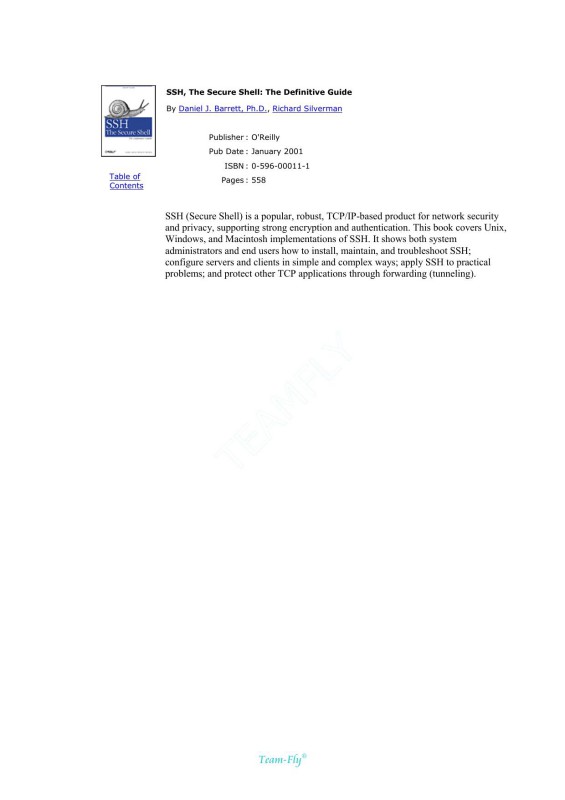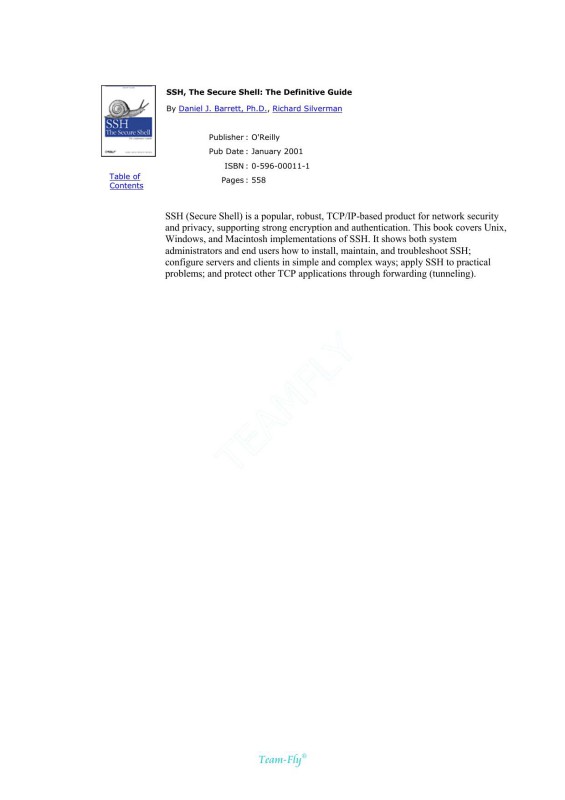SSH the Secure Shell The Definitive Guide 2nd edition by Daniel Barrett, Richard Silverman, Robert Byrnes ISBN 0596008953 9780596008956
$50.00 Original price was: $50.00.$25.00Current price is: $25.00.
Authors:Daniel J. Barrett; Richard E. Silverman; Robert G. Byrnes , Series:Cyber Security [249] , Tags:Computers; Networking; Network Protocols; Operating Systems; Unix; Linux; Security; General; Intranets & Extranets , Author sort:Barrett, Daniel J. & Silverman, Richard E. & Byrnes, Robert G. , Ids:Google; 9780596008956 , Languages:Languages:eng , Published:Published:May 2005 , Publisher:”O’Reilly Media, Inc.” , Comments:Comments:Are you serious about network security? Then check out SSH, the Secure Shell, which provides key-based authentication and transparent encryption for your network connections. It’s reliable, robust, and reasonably easy to use, and both free and commercial implementations are widely available for most operating systems. While it doesn’t solve every privacy and security problem, SSH eliminates several of them very effectively. Everything you want to know about SSH is in our second edition of SSH, The Secure Shell: The Definitive Guide. This updated book thoroughly covers the latest SSH-2 protocol for system administrators and end users interested in using this increasingly popular TCP/IP-based solution. How does it work? Whenever data is sent to the network, SSH automatically encrypts it. When data reaches its intended recipient, SSH decrypts it. The result is “transparent” encryption-users can work normally, unaware that their communications are already encrypted. SSH supports secure file transfer between computers, secure remote logins, and a unique “tunneling” capability that adds encryption to otherwise insecure network applications. With SSH, users can freely navigate the Internet, and system administrators can secure their networks or perform remote administration. Written for a wide, technical audience, SSH, The Secure Shell: The Definitive Guide covers several implementations of SSH for different operating systems and computing environments. Whether you’re an individual running Linux machines at home, a corporate network administrator with thousands of users, or a PC/Mac owner who just wants a secure way to telnet or transfer files between machines, our indispensable guide has you covered. It starts with simple installation and use of SSH, and works its way to in-depth case studies on large, sensitive computer networks. No matter where or how you’re shipping information, SSH, The Secure Shell: The Definitive Guide will show you how to do it securely.
SSH, the Secure Shell: The Definitive Guide 2nd edition by Daniel Barrett, Richard Silverman, Robert Byrnes – Ebook PDF Instant Download/Delivery. 0596008953, 978-0596008956
Full download SSH, the Secure Shell: The Definitive Guide 2nd Edition after payment

Product details:
ISBN 10: 0596008953
ISBN 13: 978-0596008956
Author: Daniel Barrett, Richard Silverman, Robert Byrnes
Are you serious about network security? Then check out SSH, the Secure Shell, which provides key-based authentication and transparent encryption for your network connections. It’s reliable, robust, and reasonably easy to use, and both free and commercial implementations are widely available for most operating systems. While it doesn’t solve every privacy and security problem, SSH eliminates several of them very effectively.
Everything you want to know about SSH is in our second edition of SSH, The Secure Shell: The Definitive Guide. This updated book thoroughly covers the latest SSH-2 protocol for system administrators and end users interested in using this increasingly popular TCP/IP-based solution.
How does it work? Whenever data is sent to the network, SSH automatically encrypts it. When data reaches its intended recipient, SSH decrypts it. The result is “transparent” encryption-users can work normally, unaware that their communications are already encrypted. SSH supports secure file transfer between computers, secure remote logins, and a unique “tunneling” capability that adds encryption to otherwise insecure network applications. With SSH, users can freely navigate the Internet, and system administrators can secure their networks or perform remote administration.
Written for a wide, technical audience, SSH, The Secure Shell: The Definitive Guide covers several implementations of SSH for different operating systems and computing environments. Whether you’re an individual running Linux machines at home, a corporate network administrator with thousands of users, or a PC/Mac owner who just wants a secure way to telnet or transfer files between machines, our indispensable guide has you covered. It starts with simple installation and use of SSH, and works its way to in-depth case studies on large, sensitive computer networks.
No matter where or how you’re shipping information, SSH, The Secure Shell: The Definitive Guide will show you how to do it securely.
SSH, the Secure Shell: The Definitive Guide 2nd Table of contents:
Chapter 1: Introduction to SSH
- 1.1 What Is SSH?
- 1.2 What SSH Is Not
- 1.3 The SSH Protocol
- 1.4 Overview of SSH Features
- 1.5 History of SSH
- 1.6 Related Technologies
- 1.7 Summary
Chapter 2: Basic Client Use
- 2.1 A Running Example
- 2.2 Remote Terminal Sessions with SSH
- 2.3 Adding Complexity to the Example
- 2.4 Authentication by Cryptographic Key
- 2.5 The SSH Agent
- 2.6 Connecting Without a Password or Passphrase
- 2.7 Miscellaneous Clients
- 2.8 Summary
Chapter 3: Inside SSH
- 3.1 Overview of Features
- 3.2 A Cryptography Primer
- 3.3 The Architecture of an SSH System
- 3.4 Inside SSH-2
- 3.5 Inside SSH-1
- 3.6 Implementation Issues
- 3.7 SSH and File Transfers (scp and sftp)
- 3.8 Algorithms Used by SSH
- 3.9 Threats SSH Can Counter
- 3.10 Threats SSH Doesn’t Prevent
- 3.11 Threats Caused by SSH
- 3.12 Summary
Chapter 4: Installation and Compile-Time Configuration
- 4.1 Overview
- 4.2 Installing OpenSSH
- 4.3 Installing Tectia
- 4.4 Software Inventory
- 4.5 Replacing r-Commands with SSH
- 4.6 Summary
Chapter 5: Serverwide Configuration
- 5.1 Running the Server
- 5.2 Server Configuration: An Overview
- 5.3 Getting Ready: Initial Setup
- 5.4 Authentication: Verifying Identities
- 5.5 Access Control: Letting People In
- 5.6 User Logins and Accounts
- 5.7 Forwarding
- 5.8 Subsystems
- 5.9 Logging and Debugging
- 5.10 Compatibility Between SSH-1 and SSH-2 Servers
- 5.11 Summary
Chapter 6: Key Management and Agents
- 6.1 What Is an Identity?
- 6.2 Creating an Identity
- 6.3 SSH Agents
- 6.4 Multiple Identities
- 6.5 PGP Authentication in Tectia
- 6.6 Tectia External Keys
- 6.7 Summary
Chapter 7: Advanced Client Use
- 7.1 How to Configure Clients
- 7.2 Precedence
- 7.3 Introduction to Verbose Mode
- 7.4 Client Configuration in Depth
- 7.5 Secure Copy with scp
- 7.6 Secure, Interactive Copy with sftp
- 7.7 Summary
Chapter 8: Per-Account Server Configuration
- 8.1 Limits of This Technique
- 8.2 Public-Key-Based Configuration
- 8.3 Hostbased Access Control
- 8.4 The User rc File
- 8.5 Summary
Chapter 9: Port Forwarding and X Forwarding
- 9.1 What Is Forwarding?
- 9.2 Port Forwarding
- 9.3 Dynamic Port Forwarding
- 9.4 X Forwarding
- 9.5 Forwarding Security: TCP-Wrappers and libwrap
- 9.6 Summary
Chapter 10: A Recommended Setup
- 10.1 The Basics
- 10.2 Compile-Time Configuration
- 10.3 Serverwide Configuration
- 10.4 Per-Account Configuration
- 10.5 Key Management
- 10.6 Client Configuration
- 10.7 Remote Home Directories (NFS, AFS)
- 10.8 Summary
Chapter 11: Case Studies
- 11.1 Unattended SSH: Batch or cron Jobs
- 11.2 FTP and SSH
- 11.3 Pine, IMAP, and SSH
- 11.4 Connecting Through a Gateway Host
- 11.5 Scalable Authentication for SSH
- 11.6 Tectia Extensions to Server Configuration Files
- 11.7 Tectia Plugins
Chapter 12: Troubleshooting and FAQ
- 12.1 Debug Messages: Your First Line of Defense
- 12.2 Problems and Solutions
- 12.3 Other SSH Resources
Chapter 13: Overview of Other Implementations
- 13.1 Common Features
- 13.2 Covered Products
- 13.3 Other SSH Products
Chapter 14: OpenSSH for Windows
- 14.1 Installation
- 14.2 Using the SSH Clients
- 14.3 Setting Up the SSH Server
- 14.4 Public-Key Authentication
- 14.5 Troubleshooting
- 14.6 Summary
Chapter 15: OpenSSH for Macintosh
- 15.1 Using the SSH Clients
- 15.2 Using the OpenSSH Server
Chapter 16: Tectia for Windows
- 16.1 Obtaining and Installing
- 16.2 Basic Client Use
- 16.3 Key Management
- 16.4 Accession Lite
- 16.5 Advanced Client Use
- 16.6 Port Forwarding
- 16.7 Connector
- 16.8 File Transfers
- 16.9 Command-Line Programs
- 16.10 Troubleshooting
- 16.11 Server
Chapter 17: SecureCRT and SecureFX for Windows
- 17.1 Obtaining and Installing
- 17.2 Basic Client Use
- 17.3 Key Management
- 17.4 Advanced Client Use
- 17.5 Forwarding
- 17.6 Command-Line Client Programs
- 17.7 File Transfer
- 17.8 Troubleshooting
- 17.9 VShell
- 17.10 Summary
Chapter 18: PuTTY for Windows
- 18.1 Obtaining and Installing
- 18.2 Basic Client Use
- 18.3 File Transfer
- 18.4 Key Management
- 18.5 Advanced Client Use
- 18.6 Forwarding
- 18.7 Summary
OpenSSH 4.0 New Features
- Server Features: sshd
- Client Features: ssh, scp, and sftp
- ssh-keygen
- Tectia Manpage for sshregex
- Regex Syntax: Egrep Patterns
- Regex Syntax: ZSH_FILEGLOB
- sshregex (Tectia) manpage
- ZSH_FILEGLOB (or Traditional) Patterns
- Character Sets for Egrep and ZSH_FILEGLOB
- Regex Syntax: SSH Patterns
Appendices
- Tectia Module Names for Debugging
- SSH-1 Features of OpenSSH and Tectia
- OpenSSH Features
- Tectia Features
- SSH Quick Reference
- Legend
- sshd Options
- sshd Keywords
- ssh Options
- scp Options
- ssh and scp Keywords
- ssh-keygen Options
- ssh-agent Options
- ssh-add Options
- Identity and Authorization Files, OpenSSH
- Identity and Authorization Files, Tectia
- Environment Variables
People also search for SSH, the Secure Shell: The Definitive Guide 2nd:
ssh the secure shell the definitive guide 2nd edition
ssh the secure shell the definitive guide
what does the secure shell ssh protocol do
the secure shell ssh authentication protocol
which port is used by the ssh secure shell protocol
You may also like…
eBook CHM
Javascript The Definitive Guide 5th Edition by David Flanagan ISBN 0596101996 9780596101992
eBook PDF
JavaScript The Definitive Guide 6th Edition by David Flanagan ISBN 0596805527 9780596805524
eBook PDF
The Ghidra Book The Definitive Guide 1st edition by Chris Eagle, Kara Nance 9781718501034 171850103X












